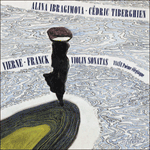With the
Poème élégiaque, Op 12, written in 1892–3, Ysaÿe moved away from the pieces he wrote merely for virtuosic purposes in his youth. The only legacy from the virtuoso practice of the past is the scordatura: the G string is here tuned to an F, giving a dark colour, the violin sounding sometimes like a viola. First written for violin and piano, Ysaÿe later orchestrated the piece. The work is dedicated to Gabriel Fauré, from whom he had already commissioned a piano quintet (Op 89, which the composer was to take a further ten years to finish). However, it was upon Ernest Chausson that the
Poème élégiaque was to have a great influence, serving as the example for the famous
Poème which he would write three years later. Ysaÿe the interpreter participated here fully in the creative process. The similarities between the two works are striking: the general atmosphere, the Wagnerism, the shape, the sublime trills at the end … Ysaÿe helped in writing the violin part, in particular the cadenza of the work which Chausson eventually called ‘mon– ton poème’ (‘my–your poème’).
from notes by Philippe Graffin © 1997
Avec le
Poème élégiaque, op. 12, écrit en 1892–3, Ysaÿe s’eloigne des simples pièces virtuoses de violoniste de sa jeunesse. Seul héritage des compositions virtuoses reste la scordatura où la corde de sol est ici accordée fa, ce qui donne une couleur sombre, le violon sonnant parfois comme un alto. D’abord écrite pour violon et piano, il l’orchestrera plus tard; l’œuvre est dediée à Gabriel Fauré, à qui il a déjà commandé un quintette avec piano, op. 89, que le compositeur mettra encore une dizaine d’années à terminer. C’est cependant sur Ernest Chausson que ce
Poème élégiaque aura une grande influence, lui servant d’exemple pour son célèbre
Poème qu’il écrira trois ans plus tard. L’interprète Ysaÿe participe ici pleinement au processus créatif, les similitudes sont frappantes entre les deux œuvres: l’atmosphère générale, son wagnérisme, sa forme, les trilles paradisiaque à la fin … Ysaÿe aidera à écrire la partie de violon, la cadence en particulier, du
Poème de Chausson que celui-ci finira par appeler «mon–ton poème».
extrait des notes rédigées par Philippe Graffin © 1997
Mit dem
Poème élégiaque, op. 12, das er 1892 und 1893 komponierte entfernte sich Ysaÿe von den einfachen Virtuosenstücken seiner Jugend. Einziger Nachlass dieser Stücke ist die Scordatura, wo die G-Saite auf F gestimmt wird, was dem Stück eine sehr dunkle Farbe verleiht, die Geige klingt teilweise fast wie eine Bratsche. Das Stück wurde zuerst für Geige und Klavier komponiert, Ysaÿe wird die Orchesterpartitur erst später schreiben; das Werk ist Gabriel Fauré gewidmet, bei dem Ysaÿe schon ein Quintett mit Klavier bestellt hat. Fauré wird jedoch zehn Jahre brauchen um dieses Quintett zu vervollständigen. Ysaÿe’s
Poème élégiaque wird jedoch den grössten Einfluss auf Ernest Chausson ausüben, es wird ihm als Beispiel für sein
Poème dienen das er drei Jahre später komponieren wird. Der Virtuose Ysaÿe wird hier voll am kreativen Prozess teilnehmen, die Ähnlichkeit zwischen den beiden Werken ist auffallend: die allgemeine Stimmung, der wagnerische Einfluss, die Form, die paradiesischen Triller am Ende … Ysaÿe wird die Geigenpartitur des
Poème von Chausson mitschreiben, besonders die Kadenz; Chausson wird das Werk später „Mein–Dein-Gedicht“ nennen.
aus dem Begleittext von Philippe Graffin © 1997
Deutsch: Canan Tollu


 Vierne & Franck: Violin Sonatas
Vierne & Franck: Violin Sonatas
